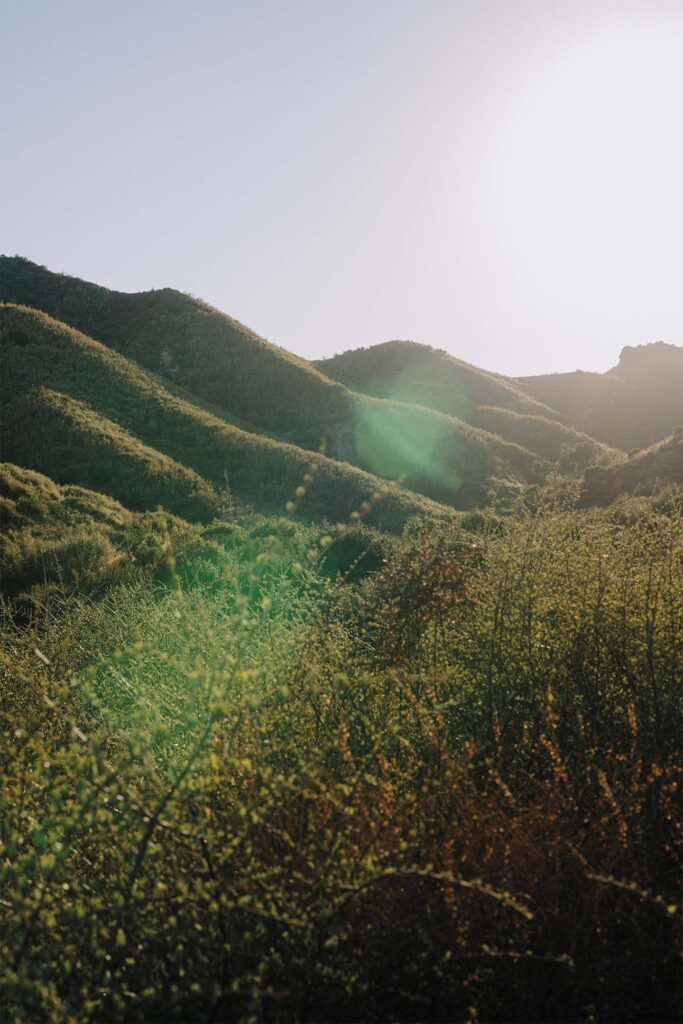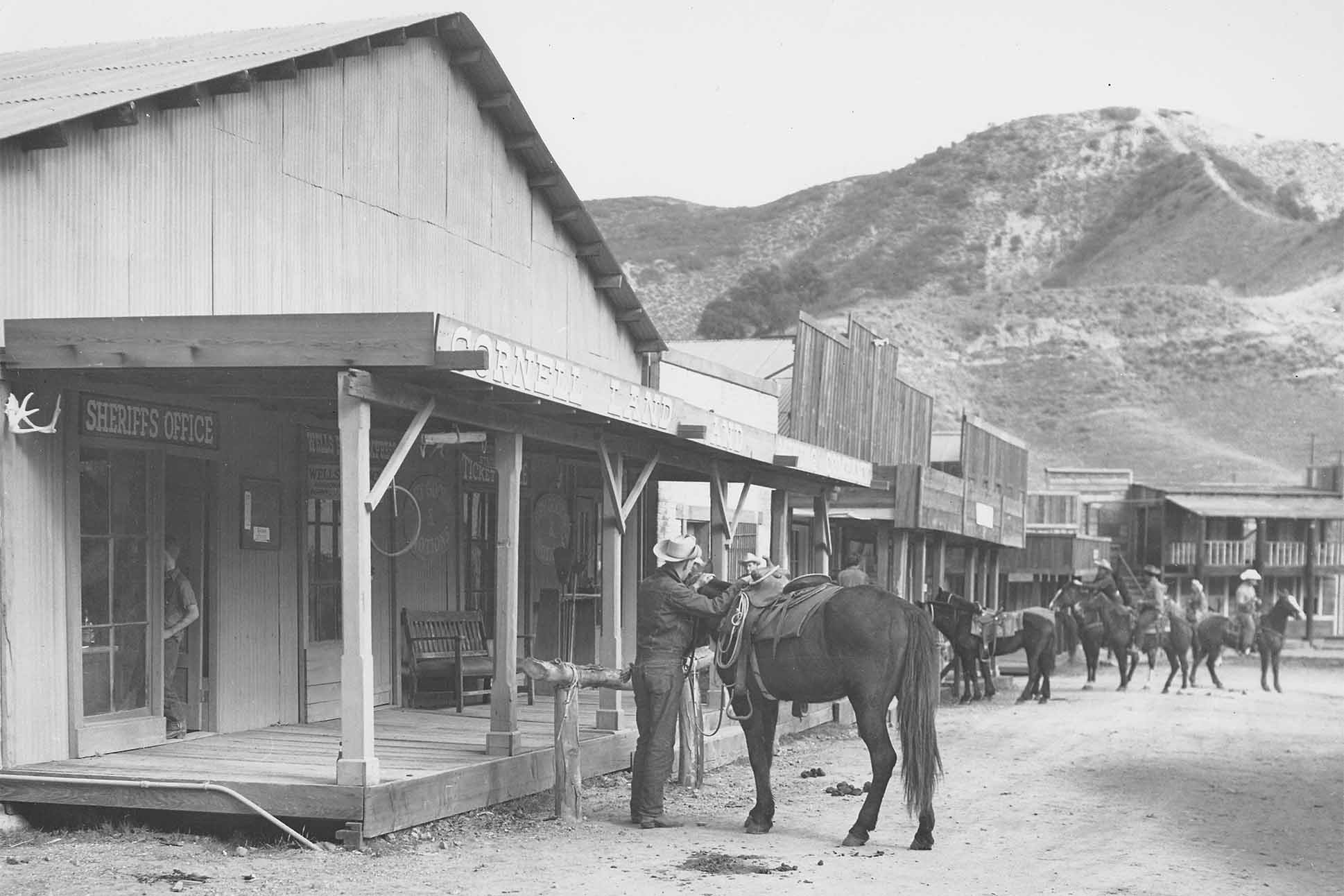Text by Lindsey Vandal
Photography by Tim Aukshunas and courtesy of Paramount Ranch
Twenty miles northeast of Malibu lies a riparian, chaparral-studded landscape rife with California sage brush, sycamore and old oak trees, red-tailed hawks, coyotes and deer, and miles of snaking trails. But unlike its neighboring parcels, this swath of land achieved celebrity status by garnering more screen time than most A-list actors. A masterful shapeshifter, the enchanting acreage has provided a characteristic backdrop for upwards of 500 film and television productions, from recreating the ruggedness of the American West to futuristic Star Trek: The Next Generation scenes born of imagination.
In 1927, movie-making powerhouse Paramount Pictures purchased 2,700 acres in the Santa Monica Mountains. The studio built a series of versatile foundational buildings—a barn, pavilion, and prop shed—in the southwest corner that would anchor temporary set pieces for wildly diverse genres. Paramount Ranch rarely played to type—posing as a Welsh mining village in How Green Was My Valley, medieval England in The Adventures of Robin Hood, an African savannah in Trader Horn, an Indian jungle in The Jungle Book, and the banks of the Mississippi River in The Adventures of Tom Sawyer. Throughout the “Paramount Era,” as it came to be known, Paramount Ranch brought more than 130 films to life and served as a multidimensional stage for the likes of Gary Cooper, Jimmy Stewart, Marlene Dietrich, and other acting royalty to hone their craft.
With the decline of Hollywood’s Golden Age, budget constraints and shifting movie-biz dynamics prompted the studio to sell Paramount Ranch in 1943. Filming continued as production companies (including Paramount Pictures) routinely leased ranch space for everything from big-budget pictures to indie films and commercial shoots. As time marched on, the ranch’s facilities became weathered and worn, and the once-waitlisted filming hub booked fewer and fewer clients.


In 1953, an enthusiastic landowner breathed new life into Paramount Ranch, commandeering 326 acres on the southeastern edge. A lifelong fan of Western movies, William Hertz constructed Western Town—a mock-up of a typical Wild West Main Street circa late-1800s that became a valuable asset for projects in the genre. He leveraged abandoned set pieces, props, and other recycled materials to craft facades of an authentic-looking saloon, hotel, and jail, and attached them to the original Paramount-Era buildings. During the “Hertz Era,” several iconic television shows—The Cisco Kid, Gunsmoke, Tombstone Territory, and The Lone Ranger—would add Paramount Ranch to their closing location credits.
“Growing up in New York, my grandfather dreamed of becoming a cowboy—so much so that he ended up selling everything and heading out West,” says David Hertz, William’s grandson. “He and his wife Betty enjoyed reviving the history of the ranch, and they also did fox hunts, equestrian shows, horse parades, and fundraisers here.” In 1955, William sold his stake in the ranch to a trio of investors who installed a two-mile sports car raceway on the property. Though the course was deconstructed a year later due to safety concerns, Paramount Ranch Raceway gained immortality after appearances in several films, including the racing drama The Devil’s Hairpin and Disney’s The Love Bug.
Paramount Ranch saw a number of private owners throughout the 1960s and 1970s. Despite the instability, Western Town remained a scene-setting vehicle for hit series such as BJ & the Bear, CHiPs, Charlie’s Angels, and M.A.S.H. In December of 1972, photographer Henry Diltz held a daylong photo shoot at the ranch with members of the classic rock band The Eagles, producing two legendary images that were featured on the front and back covers of the band’s Old West-themed Desperado album.
In 1980, two years after Congress designated 153,000 acres as the Santa Monica Mountains National Recreation Area, the National Park Service purchased roughly one-third of Paramount Ranch, including the central hub of filming operations where Western Town stood. Thanks to insight from Robert Hertz, William Hertz’s son who helped build Western Town as a 20-year-old, and black and white photos of the Hertz Era transformation, the National Park Service was able to successfully restore the timeworn Western Town set.


Over the next two decades, a revitalized Paramount Ranch accommodated a variety of mainstream productions, including The Dukes of Hazzard, The X-Files, and Dr. Quinn, Medicine Woman. The ranch harbored numerous sets for the debut season of The Mentalist in 2008, the Clint Eastwood-directed American Sniper in 2014, and the highly acclaimed HBO sci-fi series Westworld in 2015.
Beginning on Nov. 8, 2018, disaster struck as the Woolsey Fire grew to 100,000 acres in Ventura and Los Angeles Counties, including Paramount Ranch. Only two structures on the ranch survived the blaze—the white chapel prominently featured in Westworld and the recurring train depot from Dr. Quinn, Medicine Woman.
While the media focused on the downfall of Western Town, losing the original buildings erected by Paramount Pictures in the 1930s was an even greater setback. “What people saw on the outside was actually masking the historic structures buried underneath those restored sets,” says Jody Lyle, Superintendent of Santa Monica Mountains National Recreation Area.
“After the fire, we all knew something had to be done,” she adds. “We started thinking of how we could recreate the infrastructure of Paramount Ranch so it could again be a place where cinematic visions can come to life.”
With $26 million in federal disaster funding and additional support from Santa Monica Mountains Fund, the park’s official philanthropic partner, construction began in 2023 on a fresh pavilion, prop shed, barn, and restrooms in the footprints of the Paramount Era buildings. Scheduled for completion in spring of 2025 by contractor AMG & Associates, Inc. of Santa Clarita, California, with San Francisco-based Architectural Resources Group leading the design, the reconstructed Paramount Ranch hub will offer the local production community a key resource for dynamic set creation. Instead of replicating the original dirt floors, the new fire-safe buildings are set to be fully finished, providing flexible indoor and outdoor event spaces for use during filming breaks.


Lyle and fellow Paramount-Era champions view the restoration as an investment in a cinematic time capsule of sorts: “This was a place where people came together to create,” reflects Lyle. “You can see that creativity change over decades with the evolution of film, the film industry, and film storytelling—and we are honored to continue that evolution.” To that end, the National Park Service plans to work closely with film companies, partner organizations, and volunteers to build out a series of modular movie sets that will enable visitors to learn about the ranch’s film-focused history.
One of the most extraordinary facets of Paramount Ranch under the National Park Service’s authority has been the rare opportunity for visitors to observe filming in action on the sidelines of live sets. But even as the production side ebbs and flows, the ranchland remains an idyllic gathering place—often hosting ranger programs, classic movie nights, star parties, and music festivals—and a gateway to the natural world, thanks to well-maintained pathways for scenic trekking, wildlife viewing, and horseback riding.
For David Hertz, who joined the fundraising efforts of the Santa Monica Mountains Fund and has high hopes for an eventual rebuild of Western Town, Paramount Ranch is a goldmine of memories of adventure hikes and afternoons spent listening to stories from his father, who passed away in 2007. “I have the cowboy hat and horsehair riding bridle he used on set as an extra in many of the Western movies,” David recalls. “These are incredibly powerful moments that connect us to a sense of place.”
Paramount Ranch is a quick trip up the PCH from Hotel Casa del Mar and Shutters on the Beach. Just take a right at Malibu.








